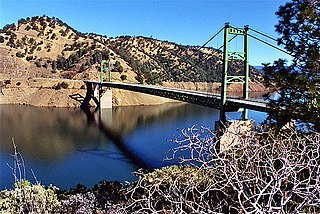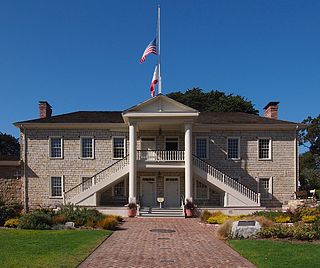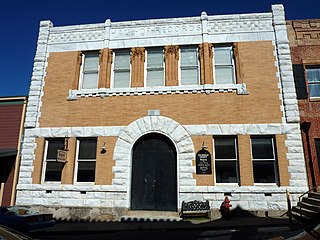
Lower Lake is a census-designated place (CDP) in the southern Clear Lake region of Lake County, in northern California. Lower Lake is also an Indian rancheria of the Koi Nation people.
Keyesville is an unincorporated community in Kern County, California. It is located 2 miles (3.2 km) west of Lake Isabella and the Kern River Valley, at an elevation of 2,848 feet (868 m). Keyesville, founded in 1854 is named for Richard M. Keyes, whose discovery of gold in 1853 started the Kern River Gold Rush. The Keyesville Townsite has been privately owned since the late 1800's and is currently encircled by BLM land Bureau of Land Management.

Clear Creek is a tributary of the upper Sacramento River in northern California.
The Stone House is the oldest building in Lake County, Northern California. The building is registered as California Historical Landmark #450 and is located in Hidden Valley Lake, California. It is open for touring quarterly and by appointment with the Stone House Historical Society.

State Route 29 is a state highway in the U.S. state of California that travels from Interstate 80 in Vallejo north to State Route 20 in Upper Lake. It serves as the primary road through the Napa Valley, providing access to the Lake County region to the north and the rest of the San Francisco Bay Area to the south.

The Bidwell Bar Bridge, in Oroville, California, is the name of two suspension bridges that cross different parts of Lake Oroville. The original Bidwell Bar Bridge was the first steel suspension bridge in California. The $35,000, 240-foot-long (73 m) original was completed in December 1855, and was built of materials transported from Troy, New York, via Cape Horn. Most of the money was put up by Judge Joseph Lewis, a Virginian who moved to Bidwell's Bar in 1849. The bridge originally crossed the Middle Fork Feather River and is the only one of several suspension bridges built in the area in the 1850s that still remains. It remained open to vehicle traffic until 1954.

Freeman Junction, a ghost town in Kern County, California, USA, was first homesteaded in the early 1870s. Freeman S. Raymond built a stage coach station here to accommodate travelers between the desert mines and Los Angeles. A group of Native Americans who were defending their homes and families in 1909 killed off the homesteaders and burned the stage station, after which the property lay dormant for several years. It was re-homesteaded in the 1920s by Clare C. Miley, who was born in 1900, and his wife. By the 1930s their small stone cabin became a gas station/car repair and later, a restaurant and some mining activities dominated the site. In 1953 a post office was planned, but never materialized and residents had to travel seven miles to Inyokern to collect their mail. By June, 1978, the town had died once again and the remains of the town have since been removed by passersby. Today, the site has reverted to its natural state and nothing remains.

The Lower Klamath National Wildlife Refuge is a National Wildlife Refuge of the United States on the border between California and Oregon. It is operated by the United States Fish and Wildlife Service. The refuge was designated a National Historic Landmark on October 16, 1965.

San Mateo Creek is a perennial stream whose watershed includes Crystal Springs Reservoir, for which it is the only natural outlet after passing Crystal Springs Dam.

Robert Louis Stevenson State Park is a California state park, located in Sonoma, Lake and Napa counties. The park offers a 5-mile (8 km) hike to the summit of Mount Saint Helena from which much of the Bay Area can be seen. On clear days it is possible to see the peak of Mount Shasta, 192 miles (310 km) distant.

Arboga is an unincorporated community in Yuba County, California. It is located 3 miles (4.8 km), south of Olivehurst on the Sacramento Northern Railroad, at an elevation of 56 feet. It was named in 1911 by the pastor of the Mission Covenant Church of Sweden for his hometown of Arboga, Sweden.

Colton Hall is a government building and museum in Monterey, California, United States. It was built in 1847–49 by Walter Colton, who arrived in Monterey as the chaplain on Commodore Robert F. Stockton's vessel. He remained and was named as Monterey's first alcalde (mayor) in the American Period. Colton Hall originally contained rooms downstairs for a public school and government assembly hall upstairs. It was the site of California's first constitutional convention in 1849.

Valley Wells is a census-designated place in Inyo County, California. Prior to 2010, for census purposes it was part of Homewood Canyon-Valley Wells CDP. The 2010 census reported that population was zero. The town is now registered as California Historical Landmark #443; in 1849, several groups of midwestern emigrants settled here to secure water from nearby Searles Lake.
Owensville is a former settlement in Inyo County, California. It was located west of the future site of the modern-day town of Laws. Owensville was started as a mining camp in 1863. By 1871 it had been abandoned. The former settlement site is on U.S. Route 6 north of Bishop, California.

Buena Vista Lake was a fresh-water lake in Kern County, California, in the Tulare Lake Basin in the southern San Joaquin Valley, California.

The Calaveras County Courthouse is a historic courthouse built in 1867 in San Andreas, California. The brick courthouse contained the county's courtroom, jail, and sheriff's office; until 1888, executions were also conducted in the building. The building's jail held outlaw Black Bart, a notorious Northern California highwayman, during his 1883 trial. The county's Hall of Records was built in front of the courthouse in 1893; the two buildings nearly touch and are considered part of the same complex.

In the United States, a one-room jail is a type of jail with only one room, or cell.

The Bullhead Point Historical and Archaeological District is located in Sturgeon Bay, Wisconsin.















